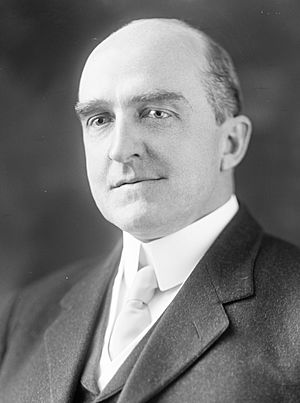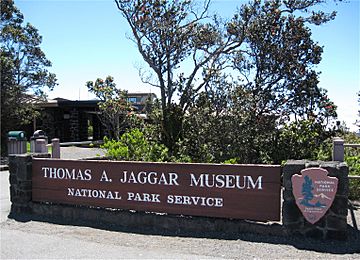Thomas Jaggar facts for kids
Quick facts for kids
Thomas Jaggar
|
|
|---|---|
 |
|
| Born | January 24, 1871 Philadelphia, Pennsylvania, U.S.
|
| Died | January 17, 1953 (aged 81) Honolulu, Territory of Hawaii, U.S.
|
| Education | Harvard University (BA, MA and PhD) |
| Occupation | Geologist |
| Spouse(s) |
Helen Kline
(m. 1903; div. 1914)Isabel Maydwell
(m. 1917) |
| Children | 2 |
| Parent(s) |
|
Thomas Augustus Jaggar Jr. (born January 24, 1871 – died January 17, 1953) was an American scientist who studied volcanoes. He is known as a volcanologist. He started the Hawaiian Volcano Observatory (HVO) and was its leader from 1912 to 1940.
Thomas Jaggar Jr. earned his PhD in geology from Harvard University in 1897. In 1902, he was one of the scientists sent by the United States to study big volcanic disasters. These happened at La Soufrière volcano and Mont Pelée. These events made him want to spend his life studying geology. He became the head of the geology department at Massachusetts Institute of Technology in 1906.
Jaggar visited Hawaii in 1909. There, he began to raise money to build the Hawaiian Volcano Observatory. He became the first director of HVO in 1912. He worked there until 1940, when he retired. He had two children and was married twice. He passed away in 1953 in Honolulu, Hawaii.
Contents
Who Was Thomas Jaggar?
Thomas Augustus Jaggar Jr. was born on January 24, 1871, in Philadelphia, Pennsylvania. His parents were Thomas Augustus Jaggar and Anna Louisa. As a child, Jaggar Jr. enjoyed hiking with his father. In 1875, he even climbed Mount Vesuvius, a famous volcano.
He earned his first college degree in 1893 and a master's degree in 1894. Both were in geology from Harvard University. Geology is the study of Earth's solid features, rocks, and processes. He then studied rocks and minerals in Germany. He earned his PhD in geology from Harvard in 1897.
In 1903, Jaggar became a geology professor at Harvard. During his summers, he worked for the United States Geological Survey (USGS). He strongly believed that doing experiments was key to understanding Earth science. He built special channels with sand and gravel to study how rivers wear away land. He also melted rocks in hot ovens to learn how magma (melted rock deep inside Earth) behaves.
As he grew as a scientist, he felt it was very important to do experiments out in the field.
Investigating Volcano Disasters
In May 1902, he was one of the scientists sent from the United States to investigate huge volcanic disasters. These happened at Soufrière and Mont Pelée. With help from the United States Navy and the National Geographic Society, Jaggar landed on the island of Martinique. This was about 13 days after the disaster. In the same year, he became a member of the American Academy of Arts and Sciences.
Jaggar married Helen Kline in 1903. They had two children, Russell Kline and Eliza Bowne. The couple later separated. In 1906, he became the head of the geology department at Massachusetts Institute of Technology. Over the next 10 years, Jaggar went on many trips. He visited places where big earthquakes and eruptions had happened. These included Italy, the Aleutian Islands, Central America, and Japan.
With each trip, Jaggar became more concerned. He felt his studies were just quick looks at long, ongoing Earth processes. After a big earthquake in Italy in 1908 killed many people, Jaggar said "something must be done." He wanted to support ongoing studies of volcanoes and earthquakes.
He traveled to Hawaii in 1909 using his own money. He decided that Kilauea volcano would be the perfect place for the first American volcano observatory. He worked on this project for the rest of his life.
In 1917, he married Isabel Maydwell, who also worked with him. Jaggar set up volcano monitoring stations at Mount Lassen and two in the Aleutian Islands. The Mount Lassen station did not last through the Great Depression. To explore hard-to-reach beaches in the Aleutian Islands, Jaggar designed special amphibious vehicles. These vehicles could travel on both land and water. They later helped the United States military during World War II. For this work, he received an award in 1945.
After he retired from the Hawaiian Volcano Observatory (HVO) in 1940, Jaggar stayed active. He worked at the University of Hawaii. He passed away in Honolulu on January 17, 1953, just before his 82nd birthday.
Hawaiian Volcano Observatory
After a talk about his trip to Martinique, Jaggar met Lorrin A. Thurston. Thurston was a lawyer and businessman in Honolulu. Like Jaggar, Thurston believed that Kilauea was a great spot for a permanent volcano observatory. He asked Jaggar, "Is it then a question of money?"
Within a year, Thurston and other business people raised money for the Hawaii Volcano Research Association. A small observation station was set up near the Halemaʻumaʻu crater. This crater is inside Kilauea's main caldera. In 1909, Jaggar received money to build the HVO. Funding also came from the Hawaii Volcano Research Association and the people of Hilo.
In 1912, construction of the HVO began. Workers dug through ash and pumice to find solid pahoehoe lava. On this lava, they placed concrete supports for seismometers. Seismometers are tools that measure ground shaking from earthquakes. In the spring of that year, Jaggar left MIT to become the first director of the HVO.
Running the Observatory
In his early years as director, Jaggar worked hard to get private donations. He hoped to eventually get money from the federal government. At one point, Jaggar even raised pigs to help fund the HVO! In 1919, Jaggar convinced the National Weather Service to provide money for the HVO.
The USGS took over running the observatory in 1924. There was a short time during the Great Depression when the National Park Service ran it. The USGS created a Section of Volcanology in 1926, and Jaggar was its first chief.
On February 3, 1923, a very strong earthquake hit off the coast of Russia. Jaggar tried to warn the harbor master in Hilo about a possible tsunami. A tsunami is a giant ocean wave caused by an earthquake. Jaggar's warning was not taken seriously. One fisherman was killed when the tsunami hit, and there was a lot of damage. This was one of the first times a tsunami warning was given for a far-off earthquake.
In 1935, Jaggar asked the United States Army to bomb a lava flow. This flow was getting close to the river that supplied water to Hilo. He hoped that bombing would break up the lava channels. This would stop the lava from flowing towards the town. The lava flow was bombed on December 27. The lava stopped flowing a few days later. Scientists still debate whether the bombing truly stopped the lava flow.
Jaggar remained director of HVO until 1940. The Thomas A. Jaggar Museum in Hawaii Volcanoes National Park is named after him. In 2018, the museum closed because earthquakes damaged its building. Many of the museum's items are now in storage.


